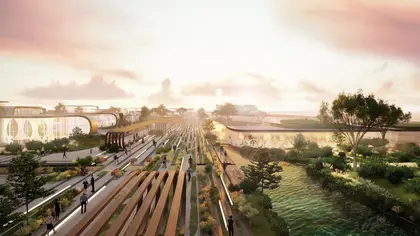On March 24, representatives of the Bureau International des Expositions (BIE) completed their Enquiry Mission to examine Ukraine’s candidature to organize World Expo 2030 in Odesa. The project is to be based on the theme “Renaissance. Technology. Future.”
Kyiv Post interviewed Manuela Gatto, director of the London-based Zaha Hadid Architects Studio, along with Yevgheniya Pozigun, Ukrainian associate o
JOIN US ON TELEGRAM
Follow our coverage of the war on the @Kyivpost_official.
For what reasons was it important for your studio to collaborate with the organizers of Odesa Expo 2030?
Gatto: It’s actually not the first time that we’ve worked onmasterplan
After the war started, we discussed the situation internally and decid
Your studio’s work on a city typically involves unders
Pozigun: By coincidence, I am from Odesa and somehow I could convey my love for my city. I think its unique characteristics include
It’s quite special to have such cosmopolitan cities on the waterline. Having an Expo that overlooks the water is aunique opportunity,
What does the area chosen for the exhibition site, the so-called “irrigation fields” represent?
Gatto: It fulfils many requirements for the organizers of the Expo on the basis that its public land. Being owned by the state means it doesn’t have to be purchased from private owners. It’s also quite central to the city center, yet currently und
It’s an area that wants to be part of the city, but also a natural habitat, so we
Architecture can be defined as art that combines space, function, values and thought. What are the values, ideas and use of spaces that form part of your masterplan for Odesa?
Gatto: I have to say that our principal driver is to create an Expo founded on sustainability. That doesn’t meanthat we’re criticizing how previous
We thought this theme of sustainability would align per
The Odesa Expo is an excellent opportunity for Ukraine’s construction industry to become a world leader in sustainable development. It’s a very different type of scheme and concept for an Expo. Let’s say, it’s unique, and different from what was done before.
Many Expos failed the subsequent challenge of reusing their exhibition spaces. What is the future vision for spaces
Gatto: We understand that past Expos have been used for displaying amazing
While some of the infrastructure and architecture will remain as an essential new facility for Odesa, we have designed some of the pavilions so that they can be dismantled and re-used in other locations. This modular concept enables the pavilions to be easily taken apart, put on a barge and shipped elsewhere in Ukraine. From there they can become schools, nurseries or whatever else is needed by the people of Ukraine.
Architects are expected to look towards the future. How do you think the Expo could inspire future developments in Odesa?
Pozigun: We anticipate that th
As one of the world’s most important international ports, Odesa really needs a venue to host these large events and welcome business delegates, industry experts and government representatives from around the world.
Our designs also incorporate long-term plans for residential developments to meet the city’s future housing demands. Now that the city center of Odessa has become a UNESCO protected site, which is really amazing because it had been plagued by unregulated de
The Expo also involves upgradi
Bringing the Expo to Odesa will be an excellent opportunity to properly plan and organize the city’s future urban development to be most effective and beneficial for the city’s residents.
You can also highlight the text and press Ctrl + Enter




